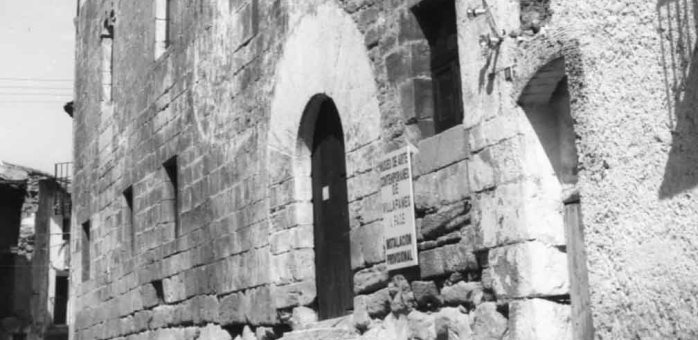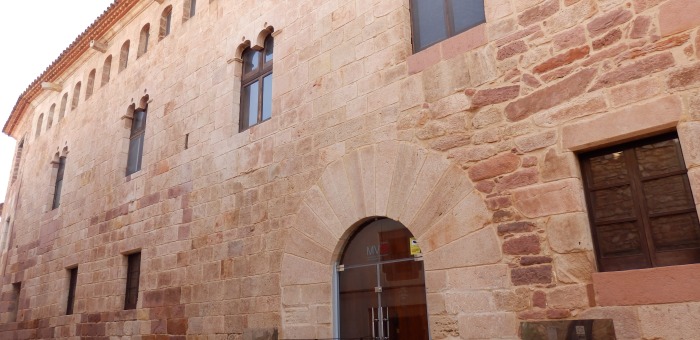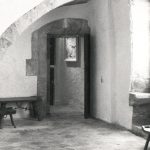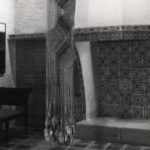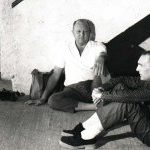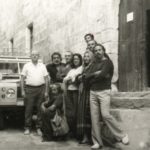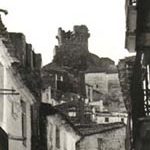the building. History:
The origins of the Museum date back to 1968, when Vicente Aguilera Cerni arrived in Vilafamés to visit his uncle Francisco Cerni Mas, who lived in this small town in the interior of Castellón. The village and its surroundings captivate Vicente Aguilera, who proposes to the local authorities the creation of a museum of contemporary art. The idea is well received by the municipal corporation and the mayor of the time, Vicente Benet. At this moment an inseparable link was born between the future Museum of Contemporary Art and the host town, Vilafamés.
In 1969 an Exhibition was held with 15 works of art at the Vilafamés Wine Museum (now Sala Quatre Cantons), with the particularity that artists had to be from the town or have a home in Vilafamés. Several artists such as Uisó Alemany, Progreso or Gabriel Cantalapiedra acquire a house in the village. On August 28 of that year, the founding act was signed.
In the summer of 1970, 23 works were collected and also exhibited at the Wine Museum. The premise imposed on artists to be able to exhibit or have work in the Museum is to have a home in Vilafamés. Thus many artists start buying and restoring houses in the old town. The purchase is quite easy, because the neighbors of the town leave the houses of the historic center to live in the lower part of the municipality, with better accessibility.
Several artists acquire a house in Vilafamés: the same D. Vicente Aguilera, Joaquín Michavila, José Palanca, Agustín de Celis and Miranda d'Amico, José Agost, Manuel Menán, Uiso Alemany, Juan Reus, Francisco Lozano, Manuel Viola, Lorenzo Frechilla, Teresa Eguibar, Manolo Salamanca, Roberta Matheu, Salvatierra, Manolo Safont, Beatriz Guttmann, Nassio Bayarri, Vicent Varella, …
The restoration work of the houses purchased by the artists is fundamental to preserve the old town of the municipality, declared of Cultural Interest by Decree 80/2005 of April 22 (DOCV n.4993, 26 April 2005; BOE n.202, 24 August 2005).
On August 30, 1970, the first Statutes of the Museum were approved, which allow the beginning of the establishment of its artistic funds through agreements with the artists.
Vicente Aguilera Cerni, using his prestige and friendship with the artists of the time, personally sends a letter to each of them, making known the creation of the museum and asking for his collaboration for the formation of the museum fund through the transfer or donation of work. The artists respond favorably to the request and in 1971 works began to arrive at the City Council of Vilafamés to the Museum, among them, a sculpture by Pablo Serrano from New York and representing the three carabelas of Columbus. With the 80 works gathered, a third exhibition is held in the basses of the Municipal Library. The inauguration invites provincial authorities, such as the President of the Provincial Council and the Civil Governor, who check on site the need to have a building for the Museum.
The Provincial Council of Castellón is responsible for buying the Bayle Palace, as well as defraying the costs of conditioning the building. On August 18, 1972, the Museum of Contemporary Art in Vilafamés opened its doors with 150 works.
Between 1972 and 1990 the presence of the Museum in Vilafamés brings with it the birth of an artistic and cultural environment in the village that, during the summer months, translates into exhibitions scattered throughout different places of the old town such as the Municipal Library, the Town Hall, the Wine Museum, the Carrer de Baix and a room enabled in the Museum itself for temporary exhibitions.
In the summer of 1976 Gabriel Cantalapiedra and Bellido Lapiedra inaugurated an exhibition located through the streets of the village of marked kitsch character. Paper-painted silhouettes represent local authorities and artists.
In 1977 the statutes and regulations of the interior regime of the Museum were published, with the aim of establishing the general rules that will regulate the situation, structure and operation of the until then called Museum of Contemporary Art of Villafamés, which from that time will be called the Popular Museum of Contemporary Art of Villafamés.
In May 1977, meetings of culture and politics took place at the Museo Popular de Arte Contemporáneo in Villafamés.
Between people and artists there is a pleasant social and even neighborhood relationship. Many artists are for years neighbors of the town. In the late 1970s and early 1980s the Museum published "A museum and a village: economic repercussions caused by the Popular Museum of Contemporary Art in Villafamés", a socio-economic study of the municipality produced by the economist Aurelio Martínez.
In 1980, Joan Miró's graphic work arrived in Vilafamés and its Museum, a temporary exhibition ceded by the Ministry of Culture. The Catalan artist donates, at this time, to the Museum of Vilafamés the work Golafre, with a handwritten dedication "for Vilafamés cordially", dated June 26, 1980.
Between 21 and 27 September 1980, the First International Meeting of Art Criticism takes place in Castellón de la Plana. The II Encuentro takes place in Peñíscola two years later, from 19 to 25 September 1982. Both meetings include internationally renowned art critics such as Gillo Dorfles, Giulio Carlo Argan, Pierre Restany… From each of these meetings a book is published with the presentations presented.
In the early 1990s the last phase of rehabilitation of the building takes place for the conditioning of new rooms, remaining the Museum closed to the public as a result of the works. In December 1991 it re-opened its doors.
Among the activities carried out by the Museum in these early years it is worth highlighting the custody, between 1979 and 1991, of the fund of the Museum of Solidarity "Salvador Allende". Nearly 150 works – painting, engravings, sculpture, ceramics, tapestypes… – are part of this background that is born and grows thanks to donations from artists who show their solidarity for the political situation that Chile is going through at the time. From Vilafamés there will be several traveling exhibitions with works from the Museum "Salvador Allende".
Coinciding with the XXV Anniversary of the Museum, the International Center for Artistic Documentation "Vicente Aguilera Cerni" is inaugurated, located in a building built by the Municipality of Vilafamés expressly in order to house the personal documentary fund that was originally ceded by Mr. Vicente Aguilera Cerni.
In 2000, an inventory work was carried out on the museum fund and its move to digital format.
In 2001, the Museum, together with the Documentation Center, held a Conference on the Conservation and Dissemination of The Memory of Art on 14 and 15 December.
In 2003, the Popular Museum of Contemporary Art in Villafamés officially changed its name and was renamed Museu d'Art Contemporani "Vicente Aguilera Cerni" in Vilafamés.
Since 2008, the Museum has maintained a collaboration agreement with the Valencian Institute of Restoration for the maintenance and conservation of the museum's works.
In 2010 the institution received the silver medal from the Consell Valencié de Cultura for its career.
In 2012, on the occasion of the 40th anniversary, a DVD is released in collaboration with the Caja Rural del Mediterráneo (CRM), "Artists of a People".
In 2015 the professor of Aesthetics Rosalía Torrent assumed the direction of MACVAC.
In 2019 the celebrations of the 50th anniversary begin. Cadena Ser (Radio Castellón) awards him the Art Award for his career.




